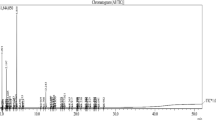Abstract
Four major chemotypes ofCyperus rotundus L. (purple nutsedge) have been reported based on the composition of essential oils in mature tubers. Distribution of the H, M, K, and O type in countries of the Pacific Rim and Basin was investigated. In general, the H type dominates on the islands of Japan, and the O type has the widest range of distribution. The O type also dominates the Pacific Basin islands except for Hawaii, where the K-type is dominant. Inhibitory activity of the essential oils fromC. rotundus tubers against the seedling growth of lettuce and oats was in the order of H > M > K > O. Seven major sesquiterpenes were isolated from the oils and their inhibitory activities determined. Results suggest thatC. rotundus of different chemotypes may have different allelopathic activity in the crop-weed interaction.
Similar content being viewed by others
References
Backer, C.A., andBakhuizen van der Brink, Jr., R.C. 1968.Cyperus L. in pp. 468–481, Flora of Java Vol. 3. Published under the auspices of the Rijksherbrium, Leyden, The Netherlands.
Holm, L. 1971. The role of weeds in human affairs.Weed Sci. 19:485–490.
Komai, K., andTang, C.S. 1989. A chemotype ofCyperus rotundus in Hawaii.Phytochemistry 28:1883–1886.
Komai, K., andUeki, K. 1981. Geographical variation of essential oils in tubers of purple nutsedge. Pages 387–389.in Proceedings, 8th Asian Pacific Weed Science Society Conference, Nov. 22–29, 1981, Bangalore, India.
Komai, K., Iwamura, J., andUeki, K. 1977. Isolation, identification and physiological activities of sesquiterpenes in purple nutsedge.Weed Res. (Japan) 22:14.
Putnam, A., andTang, C.S. (eds.) 1986. Allelopathy: State of the science, pp. 1–19,in A. Putnam and C.S. Tang (eds.). The Science of Allelopathy. John Wiley & Sons, New York.
Siriwardana, T.D. 1986. Low rates of glyphosate for management ofCyperus rotundus L., PhD dissertation. University of Hawaii. 118 pp.
William, R.D., andWarren, G.F. 1975. Competition between purple nutsedge and vegetables.Weed Sci. 23:317–323.
Author information
Authors and Affiliations
Additional information
On leave from the Department of Agricultural Biochemistry.
Rights and permissions
About this article
Cite this article
Komai, K., Tang, CS. & Nishimoto, R.K. Chemotypes ofCyperus rotundus in Pacific Rim and Basin: Distribution and inhibitory activities of their essential oils. Journal of Chemical Ecology 17, 1–8 (1991). https://doi.org/10.1007/BF00994417
Received:
Accepted:
Issue Date:
DOI: https://doi.org/10.1007/BF00994417




